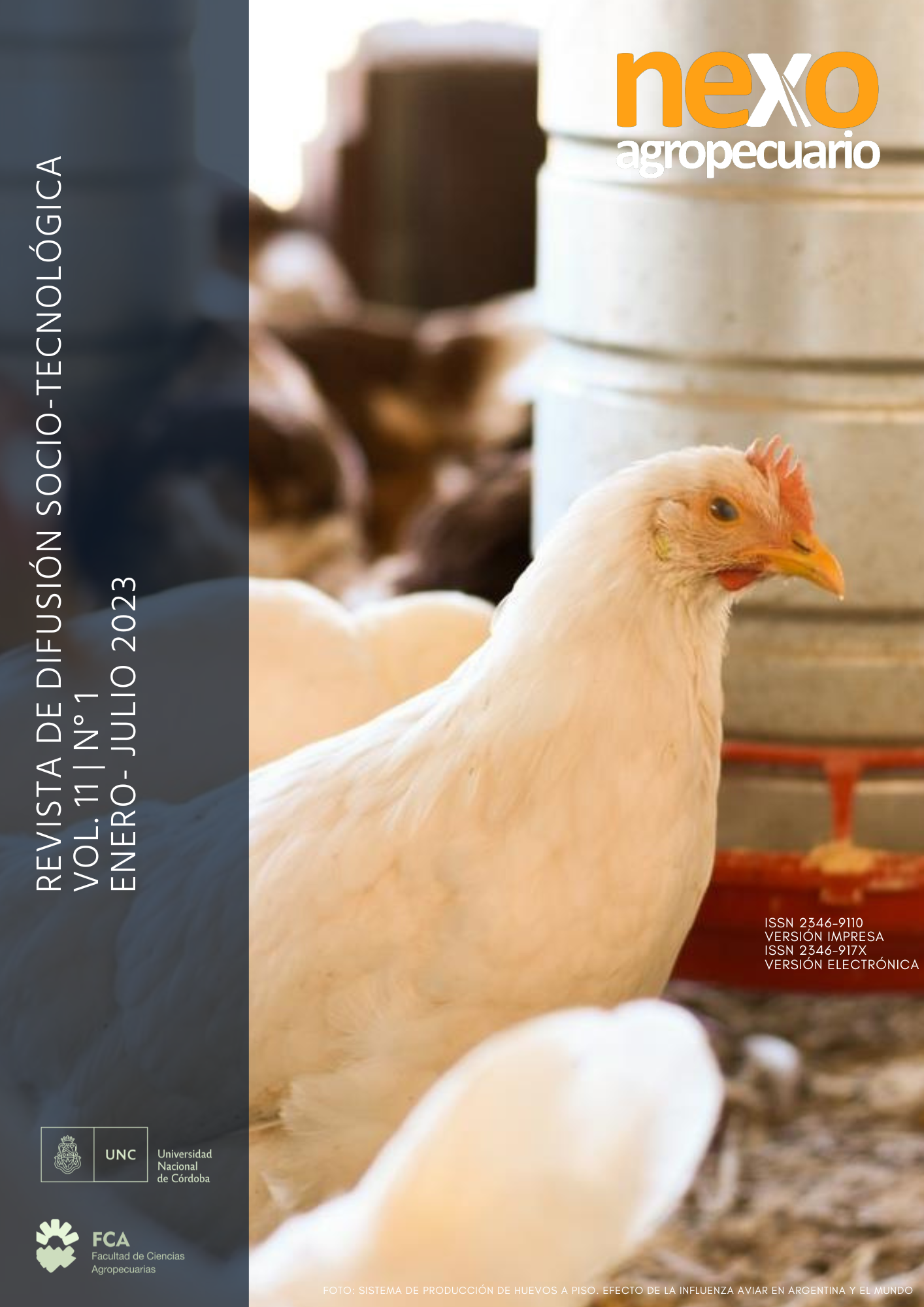USO DEL PLASMA NO TÉRMICO PARA LA MEJORA DE LA CALIDAD FISIOLÓGICA EN SEMILLA DE GARBANZO (Cicer arietinum L. cv. Felipe UNC-INTA)
Palabras clave:
plasmas no térmicos, crecimiento de plántulas, respuesta trifásica de la germinaciónResumen
El objetivo de este trabajo fue evaluar el impacto que poseen los tratamientos con plasmas no térmicos (PNT) sobre la calidad fisiológica de semillas de garbanzo en términos de respuesta trifásica, germinación y vigor. Las semillas fueron tratadas con una descarga de barrera dieléctricadurante 3 minutos y se utilizaron dos gases de arrastre: nitrógeno y oxígeno. Del análisis de los resultados surge que ambos tratamientos de plasma favorecen la respuesta fisiológica de la germinación, aumentando la velocidad de imbibición en la fase I, lo que activa el metabolismo en fase II y se visualiza en el incremento del crecimiento de la plántula en fase III. Estas modificaciones fisiológicas explican el mayor vigor de las plántulas por impacto de los tratamientos. La implementación de esta tecnología para el tratamiento de semillas desde el punto de vista agronómico, favorecen el establecimiento de plantas a campo, además de beneficiar la sustentabilidad ambiental.
Referencias
Adamovich, I. et al. The 2017 Plasma Roadmap: Low temperature plasma science and technology. J. Phys. D: Appl. Phys. 50, 323001.
Azcón–Bieto J., Talón M. 2001. Fundamentos de Fisiología Vegetal. Editorial McGraw–Hill Interamericana. Primera Edición. Madrid, España. 522 p.
Bewley JD & M Black. 1994. Seed: physiology of development and germination. 2 ed. New York: Plenum Press.
Bewley JD. 1997.Seed germination and dor¬mancy. The Plant Cell. 9: 1055-1066.
Bormashenko, E., Grynyov, R., Bormashenko, Y Drori, E.2012 Cold radiofrequency plasma treatment modifies wettability and germination speed of plant seeds. Sci. Rep. 2, 741–748 pp.
Brandenburg, R. 2017. Dielectric barrier discharges: Progress on plasma sources and on the understanding of regimes and single filaments. Plasma Sources Science and Technology, 26 (5), 053001.
Carreras J., Regginato J. y Fiant S. 2018. Producción de semillas y provisión de insumos. La cadena de valor del garbanzo en Córdoba. Bolsa de Cereales de Córdoba. Cap. 2, 11 – 19 pp.
Carreras, J. Mazzuferi V. y Karlin M.2016. El cultivo de garbanzo (Cicer arietinumL.) en Argentina. Córdoba: Universidad Nacional de Córdoba, 567p.
De Groot, G.J.J.B., Hundt, A., Murphy, A.B., Bange, M.P., Mai-Prochnow, A. 2018. Cold plasma treatment forcotton seed germination improvement. Sci. Rep. 8, 14372.
Hardegree, S. P. & Emmerich, W. E. 1992. Effect of matric-priming duration and priming water potential on germination of four grasses. Journal of Experimental Botany, 43 (2), 233-238 pp.
International Seedling Test Association (ISTA). 2022. International Rules for seed testing: Edition 2021. Zurich, Switzerland, 300 p.
Laroussi, M. 2005. Low temperature plasma-based sterilization: Overview and state of the art. Plasma Processes and Polymers, 2(5), 391–400 pp.
Li, L., Jiang, J., Li, J., Shen, M., Xe, X., Shao, H., Yuanhua, D. 2014. Effects of cold plasma treatment on seed germination and seedling growth of soybean. Sci. Rep. 4, 5859–5865 pp.
Meng, Y., Qu, G., Wang, T., Sun, Q., Liang, D., Hu, S.2017. Enhancement of germination and seedling growth of wheat seed using dielectric barrier discharge plasma with various gas sources. Plasma Chem. Plasma Proc. 37, 1105–1119 pp.
Mildaziene, V. Ivankov, A. Sera, B. Baniulis, D. 2022. Biochemical and Physiological Plant Processes Affected by Seed Treatment with Non-Thermal Plasma. Plants, 11, 856
Misra, N.N.; Schlutter, O., Cullen, P. 2016. Plasma in Food and agriculture. In Cold Plasma in Food and Agriculture: Fundamentals and Applications; Misra, N.N., Schlutter, O., Cullen, P.J.M., Eds.; Elsevier: Amsterdam, The Netherlands; 1–16 pp.
Mitra, A., Li, Y.F., Klämpfl, T.G., Shimizu, T., Jeon, J., Morfill, G.E., Zimmermann, J.L. 2014. Inactivation of surface-borne microorganisms and increased germination of seed specimen by cold atmospheric plasma. Food Bioprocess Technol. 7, 645–653 pp.
Obroucheva NV & OV Antipova. 1989.Seed hydration as a trigger of cell elongation in bean hypocotyl and radicle. En: Lough¬man BC, O Gaspacikova & J Kolek, eds. Structural and functional aspects of trans¬port in roots. Dordrecht: Kluwer Acade¬mic, 41-44.
Pérez-Pizá, M. C., Prevosto, L., Zilli, C., Cejas, E., Kelly, H., & Balestrasse, K. 2018. Effects of non–thermal plasmas on seed-borne Diaporthe/Phomopsis complex and germination parameters of soybean seeds. Innovative Food Science & Emerging Technologies, 49, 82-91 pp.
Prado C, Rayó MA y Devani M. 2018. Calidad de semilla de garbanzo producida en el NOA en las últimas 5 campañas. Reporte agroindustrial N°153. EEAOC. Tucumán. Argentina.
Šerá, B. Scholtz, V. Jirešová, J. Khun, J. Julák, J. Šerý, M. 2021.Effects of Non-Thermal Plasma Treatment on Seed Germination and Early Growth of Leguminous. Plants—A Review. Plants, 10, 1616.
Singer, S. J.; Nicolson, Garth L. 1972. The Fluid Mosaic Model of the Structure of Cell Membranes. Science 175 (4023) 720-731 pp.
Stolárik, T., Henselová, M., Martinka, M., Novák, O., Zahoranová, A., Cˇ ernák, M.2015. Effect of Low-Temperature Plasma on the Structure of Seeds, Growth and Metabolism of Endogenous Phytohormones in Pea (Pisum sativum L.). Plasma Chem. Plasma Proc. 35, 659–676 pp.
Suárez, D. & Melgarejo, L. M. 2010. Biología y germinación de semillas. Experimentos en Fisiología Vegetal, Colombia, 13-249 pp.
Zahoranová, A., Henselová, M., Hudecová, D., Kalinˇáková, B., Kovácˇik, D., Medvecká, V., Cˇ ernák, M. 2015. Effect of cold atmospheric pressure plasma on the wheat seedlings vigor and on the inactivation of microorganisms on the seeds surface. Plasma Chem. Plasma Process. 36, 397–414 pp.
Descargas
Publicado
Número
Sección
Licencia
Derechos de autor 2023 Ada Silvana Vélez, K. B. Balestrasse, B. L. Fina, L. Prevosto, M. Ferreyra, B. Santamaría, C. Zilli, J. A. Arg¨üello

Esta obra está bajo una licencia internacional Creative Commons Atribución-NoComercial-CompartirIgual 4.0.
Atribución – No Comercial – Compartir Igual (by-nc-sa): No se permite un uso comercial de la obra original ni de las posibles obras derivadas, la distribución de las cuales se debe hacer con una licencia igual a la que regula la obra original.


